Best fruit trees: 24 varieties for tasty homegrown crops
The best fruit trees will produce delicious and bountiful fruit, cheaper and tastier than anything you can get in store


Growing the best fruit trees for your own flavorsome fruit is easy when you know which tree to buy. Homegrown fruit tastes ten times better than shop-bought produce, contains a greater density of nutrients, and it’s free.
There is a fruit tree that’s perfect for every garden and the needs of the people in it. For instance, if you have a shady garden in a cool climate region and you do lots of baking, a sour cherry could be perfect; whereas a fig may be better suited to someone with a sun-baked terrace who wants to eat fruit straight off the tree.
There is sure to be a fruity, deciduous or evergreen tree to suit you amongst our list of the best fruit trees to grow.
Get bountiful produce from one of the best fruit trees
When it comes to choosing a tree for your garden, there are many considerations, from aspect, garden size and soil type. So we've included a variety of options for the best fruit trees to suit a range of conditions and needs.
The one thing they have in common is that they will all give delicious fruit.
Apple trees
1. Malus domestica ‘Scrumptious’

- Hardiness: USDA 3-9 (UK H6)
- Height: 8-10ft (2.5-3m) on M26 rootstock; 10-13ft (3-4m) on MM106 rootstock
- Spread: 12ft (3.6m)
- Best for: A specimen tree
A dessert (eating) apple planted as a ‘specimen’ tree – i.e. planted alone, as a focal point – is perhaps the most traditional option for a fruit tree.
‘If space allows, place your apple tree in the middle of an open space so that you can walk around it from all sides,’ says Jessica Soulliere, owner of Potager Garden Design, LLC and The Ferry Street Nursery Project in Detroit, Michigan. ‘This means there is also space to prune where needed and pick fruits.’
Scrumptious is a wonderful self-fertile disease-resistant variety that becomes one of the best flowering trees in spring, producing a snow of pale-pink blossom, followed by a crop of honey-flavored red-skinned eating apples in early fall. It will grow best in well-drained soil in full sun.
2. Malus domestica 'Annie Elizabeth’
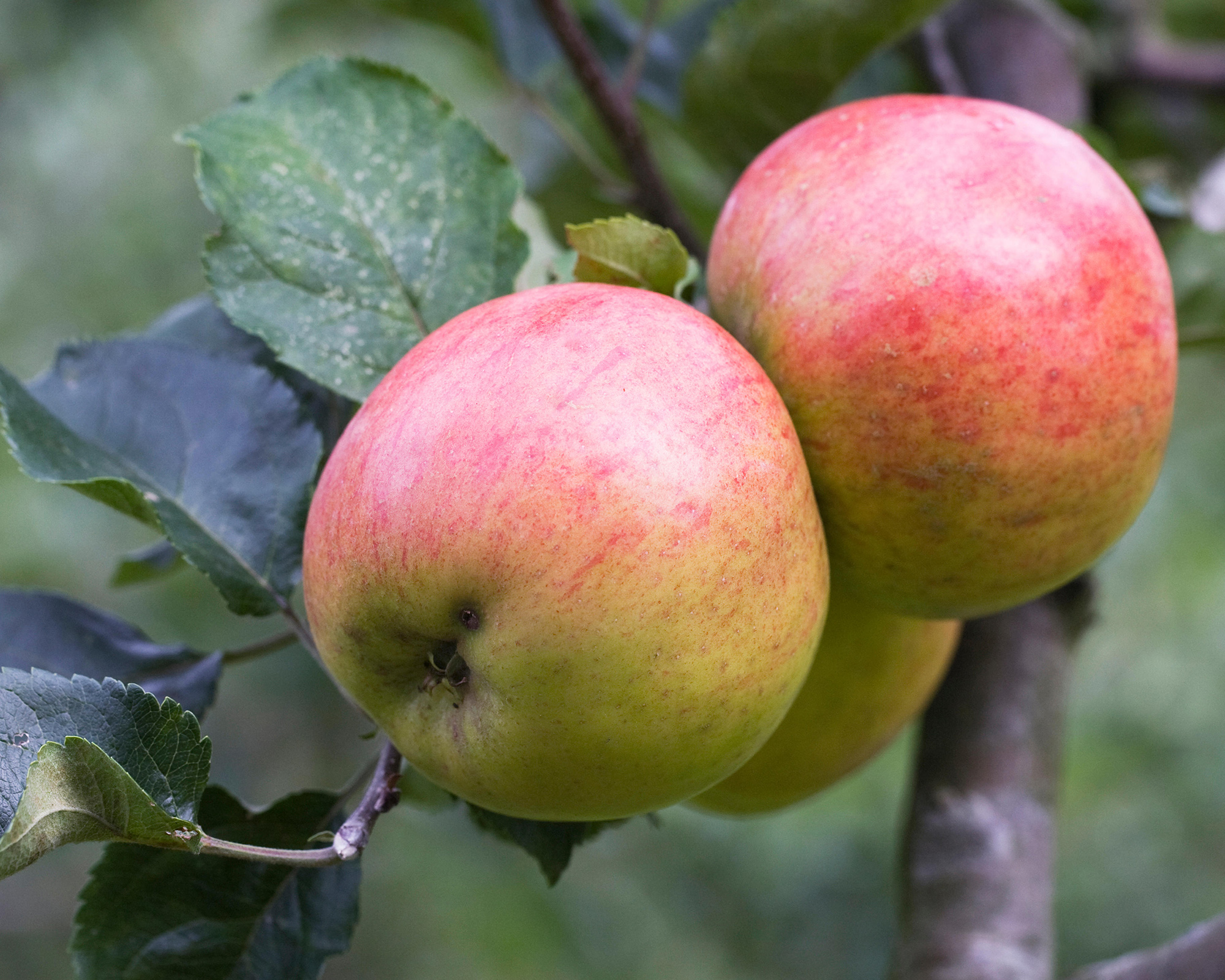
- Hardiness: USDA 3-9 (UK H6)
- Height: 8-10ft (2.5-3m) on M26 rootstock; 10-13ft (3-4m) on MM106 rootstock
- Spread: 12ft (3.6m)
- Best for: Apple pie
Whip up delicious, warming apple puddings in fall and winter by growing your own cooking apple tree. 'Annie Elizabeth’ is a fabulous choice for stewing and baking. It has gorgeous deep-pink spring blossom and yellow and red fruit, which ripens in fall.
Boasting a lovely sweet flavor, it doesn’t require as much sugar (if any) as some varieties. It also stores well and can be grown in colder regions. It is partially self-fertile, meaning that it would benefit from another apple tree in the vicinity to produce a great crop of fruit.
The RHS says this variety has average resistance to apple tree diseases. Plant in well-drained soil in full sun.
3. Malus domestica 'Fiesta'
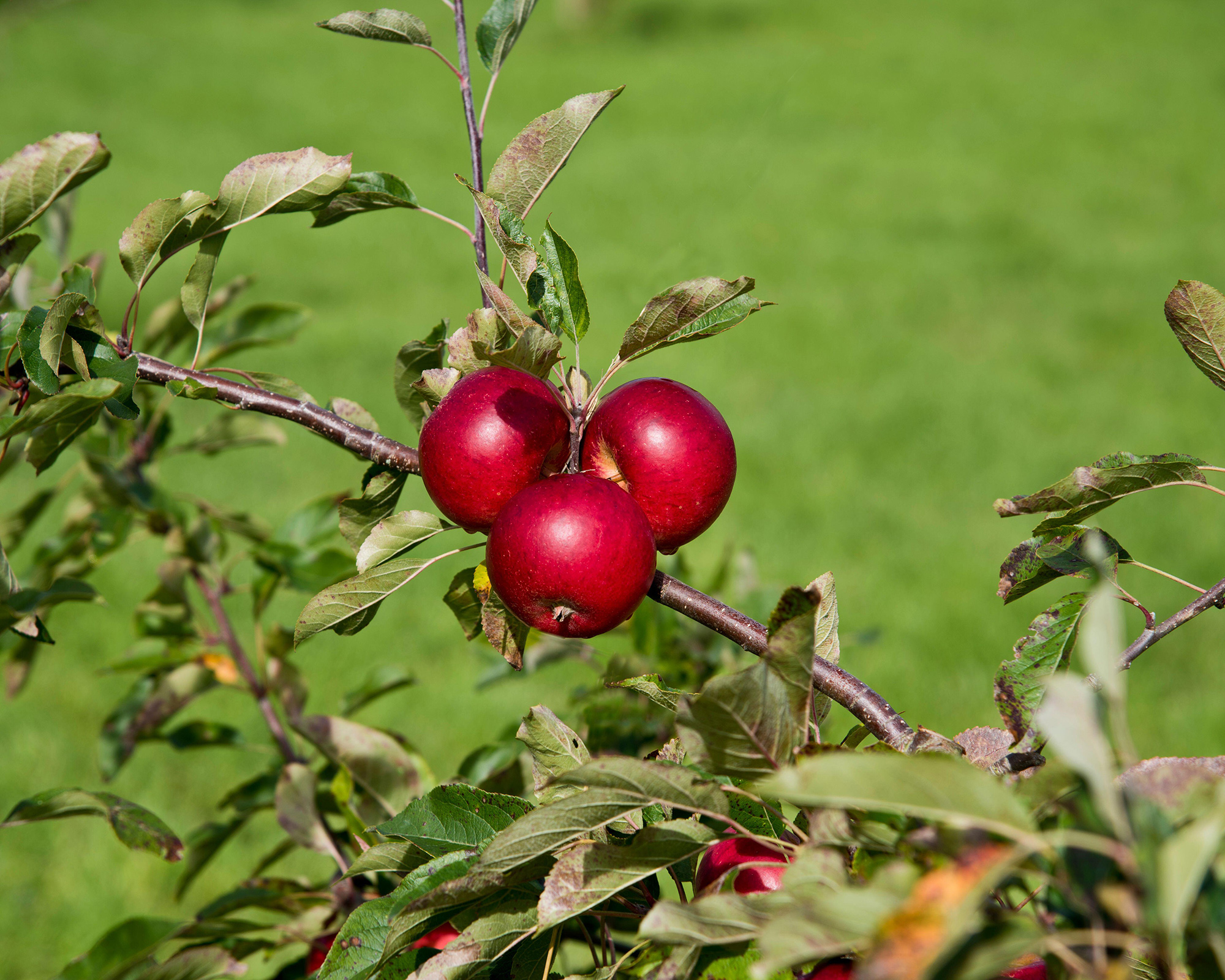
- Hardiness: USDA 3-9 (UK H6)
- Height: 4-6ft (1.2-1.8m)
- Spread: 5ft (1.5m)
- Best for: Dividing areas
Apple fences (also known as ‘step-overs’) are low-growing, horizontally trained apple trees that are ideal trees for small gardens or for dividing areas in large gardens.
‘Apple fencing is a great way to add in a decorative division,’ says Los Angeles based landscape designer Laura Morton. ‘It adds seasonal interest and makes it easier to harvest the fruit.’
A step-over consists of one tree with two long horizontal arms, forming a T shape. If you don’t fancy creating one yourself, they are available ready-trained on M27 rootstock.
‘Fiesta’ is partially self-fertile, so would benefit from another apple in the vicinity; it produces soft-pink spring blossom and sweet-tasting dessert apples in mid-fall. Performs best in well-drained soil in full sun.
4. Malus 'John Downie'
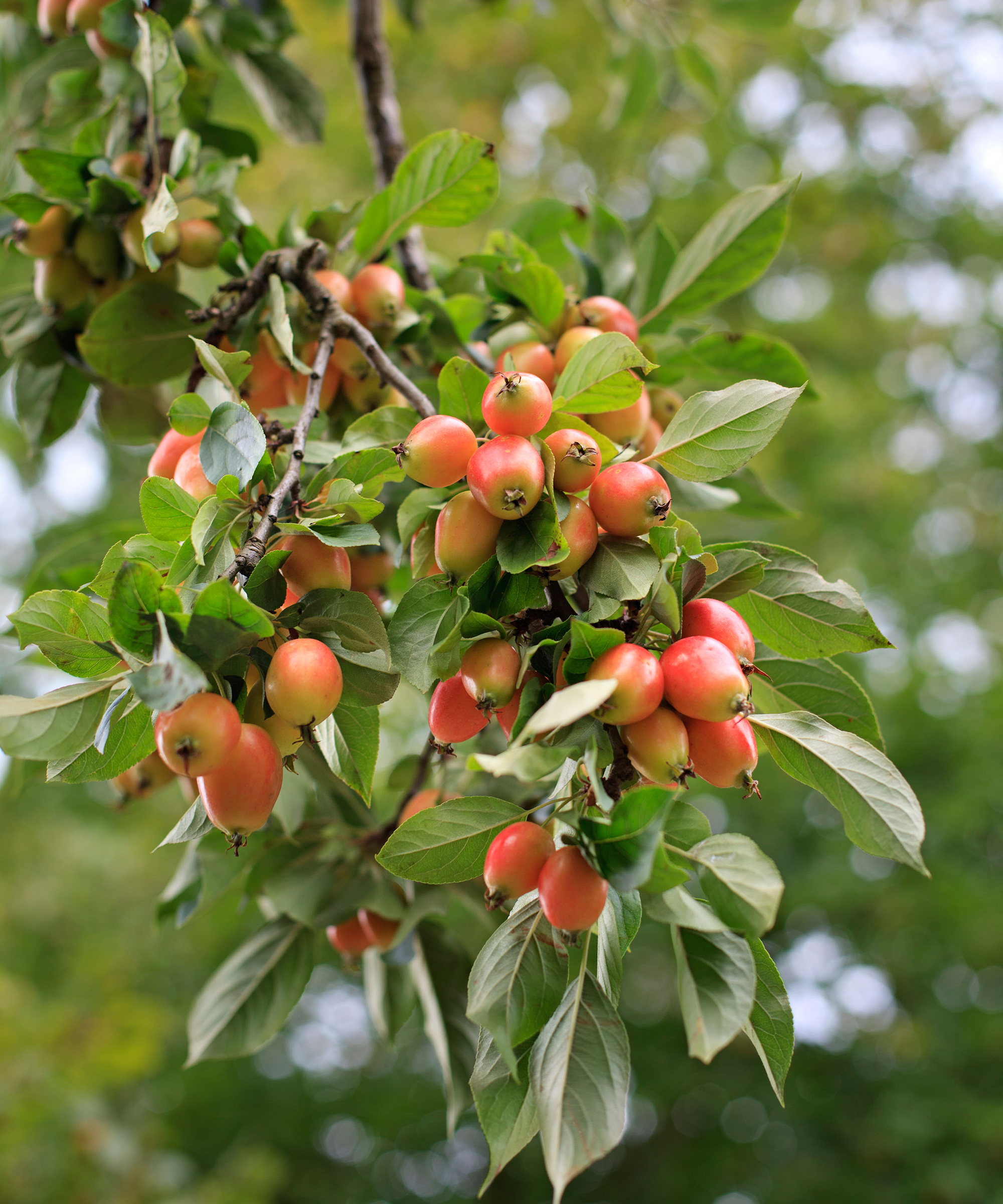
- Hardiness: USDA 3-9 (UK H6)
- Height: 13ft (4m)
- Spread: 10m (3m)
- Best for: Wildlife
Apple trees (Malus) not only give us fruit – they are also excellent wildlife plants, especially crab apples.
‘Apple trees are a good source of forage for bumblebee queens in springtime and for red mason bees, which are active in spring,’ says bee expert Dave Goulson, author of The Garden Jungle, available at Amazon.
‘Plus, the bee visits help to ensure a good crop. All varieties of apple seem to be pretty good, but some of the crab apples, such as ‘John Downie’ produce particularly profuse flowers and are also very attractive.’
As well as the lovely cloud of white spring blossom, which opens from pink buds, ‘John Downie’ is a self-fertile backyard tree that produces a mass of red and orange fruit in fall, which is rich in vitamin C and can be made into crab apple jelly. Plant in well-drained soil in sun.
Pear trees
5. Pyrus communis 'Concorde'
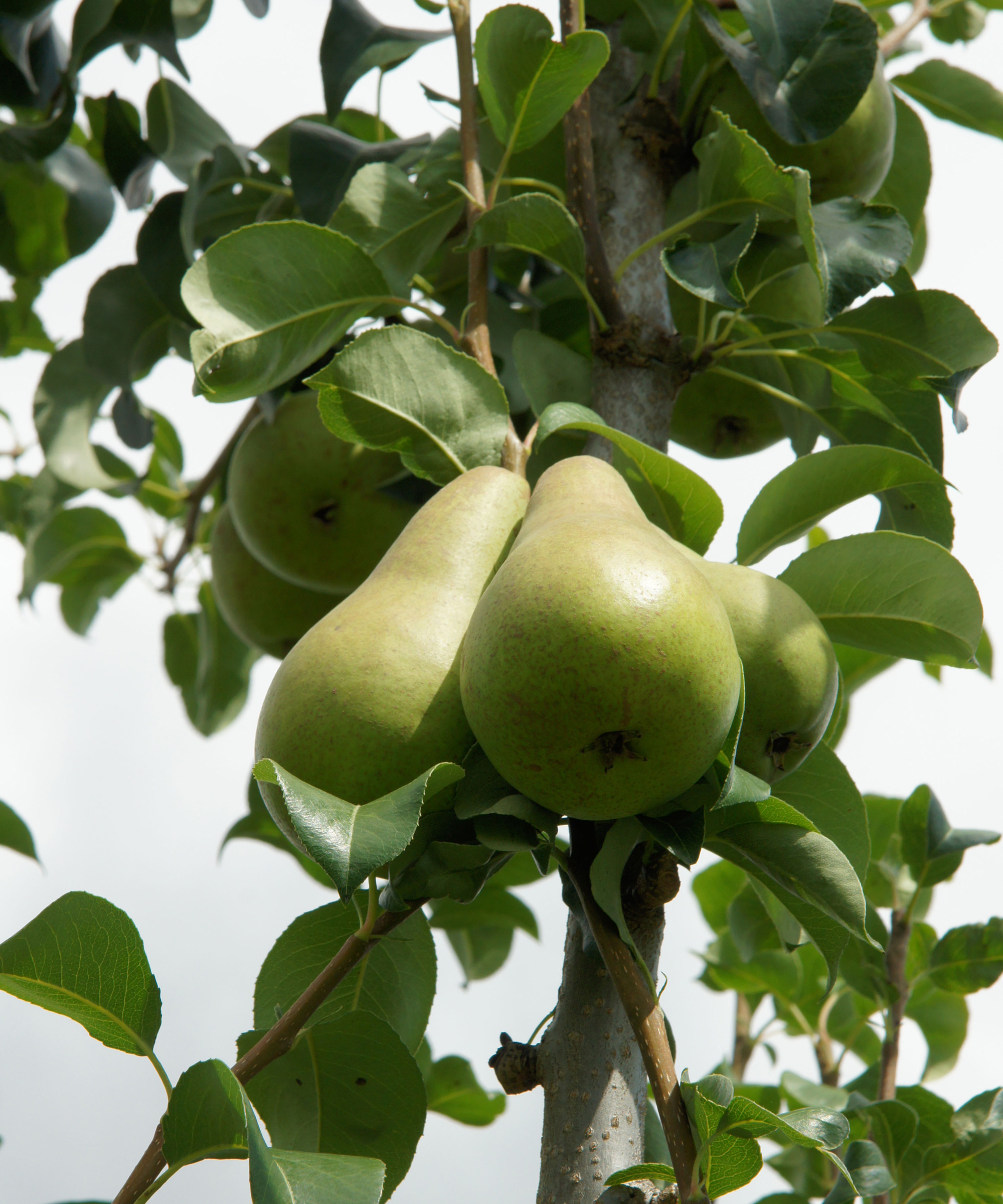
- Hardiness: USDA 3-9 (UK H6)
- Height: 8-10ft (2.4-3m) on Quince C rootstock; 10-12ft (3-3.6m) on Quince A rootstock
- Spread: 9-12ft (2.7-3.6m)
- Best for: Flavor
Home-grown pears taste much more delicious than shop-bought fruit and the trees produce a glorious show of white blossom in springtime. ‘Concorde’ is a healthy, compact variety, making it suitable for the average small garden or it could be used as a front yard tree.
The yellow fruit is sweet and juicy and produced in abundance. It is partially self-fertile, so would benefit from another tree nearby to produce a good crop. Grow in well-drained soil in a sheltered spot in full sun.
6. Pyrus communis ‘Conference'

- Hardiness: USDA 3-9 (UK H6)
- Height: 10-12ft (3-3.6m) on Quince A rootstock
- Spread: 12ft (3.6m)
- Best for: Elegant structure
An espalier is a pear (or apple) tree trained into horizontal tiers, usually against a wall or the side of the house. At all times of year, they look elegant and sophisticated and, when planted in well-drained soil in sheltered sun, they can live for a long time.
They are fun to train yourself or can be bought ready-trained as 1, 2, or 3-tier espaliers, so that they achieve height and productivity faster.
‘Conference’ is a reliable dessert variety, with white spring blossom and golden-green delicious fruit in mid to late fall. It is partially self-fertile, so will crop better if there is another pear in the vicinity, but if that is not possible, it will fruit on its own.
7. Pyrus pyrifolia (Asian pear)

- Hardiness: USDA 5-9 (UK H6)
- Height: 20-30ft (6-9m)
- Spread: 10-13ft (3-4m)
- Best for: Unusual fruit
Resembling a cross between an apple and a pear, the Asian pear produces unusual apple-shaped fruit with pear-like golden-brown skin. It has the crunchy texture of an apple and juicy flesh of a pear and can be eaten raw or used in cooking. In spring, it produces white blossom that feeds pollinators.
‘Asian pears are my go-to fruit trees for clients,’ says Connecticut-based landscape-designer Donna Christensen. ‘It produces a great deal of tasty fruit early in its development.’ Plant in well-drained, fertile soil in sheltered sun.
Plum, gages and damson trees
8. Prunus domestica ‘Opal’
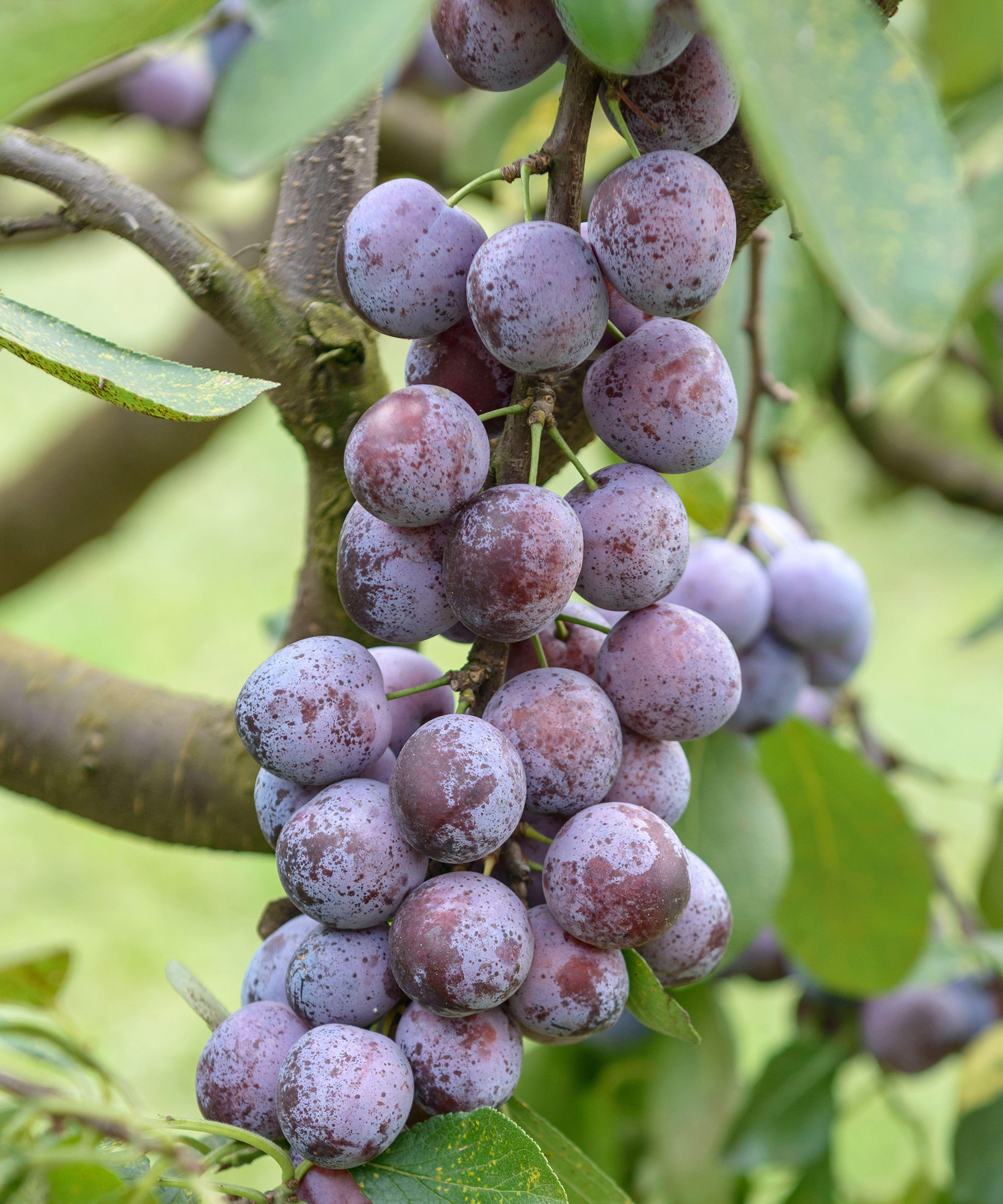
- Hardiness: USDA 5-9 (UK H6)
- Height: 7-9ft (2.1-2.7m) on VVA-1 rootstock; 10-12ft (3-3.6m) on Adaptabil rootstock
- Spread: 9-12ft (2.7-3.6m)
- Best for: Fresh fruit
A delicious, low maintenance tree which reliably produces plums, with fruit reminiscent of a small ‘Victoria’ English plum. The skin is gold and ruby purple and the yellow sweet, juicy flesh comes away from the stone easily.
Being self-fertile, it produces its early-season dessert crop without needing other plum trees nearby, and the fruit can be eaten fresh or used for cooking. On top of this, the tree has an attractive pyramidal shape and is coated in white blossom during spring.
For the best chance of success with growing plums, plant this variety in well-drained soil in sheltered sun.
9. Prunus domestica 'Oullins Gage'
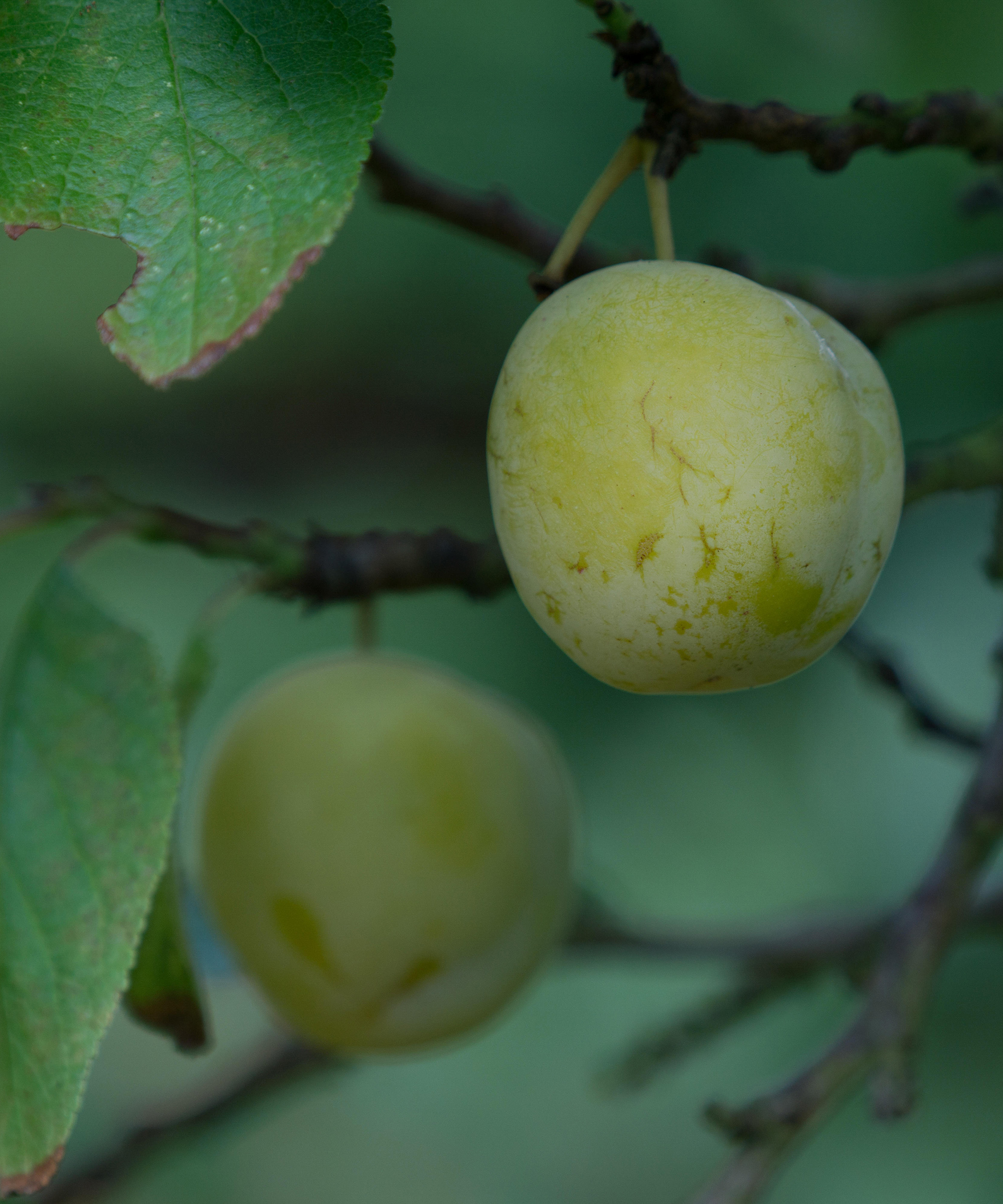
- Hardiness: USDA 5-9 (UK H5)
- Height: 7-9ft (2.1-2.7m) on VVA-1 rootstock; 10-12ft (3-3.6m) on Adaptabil rootstock
- Spread: 9-12ft (2.7-3.6m)
- Best for: Greengage tart
Gages are widely grown in gardens in France, their taste is reminiscent of a plum, although not always as sweet; they are often golden green in color, with a rounder shape than most plums.
Gages can be used for eating or cooking or both, depending on the cultivar. Ensure the fruit is ripe before picking – the skin around the stalk will look slightly wrinkled when they are ready.
'Oullins Gage' is a reliable self-fertile French variety that has spring blossom and juicy, sweet fruit in late summer and can be grown in cooler regions.
Plant in well-drained soil. These are not the best trees for shade as they prefer a sunny spot, and you can either eat the fruit fresh or use it to make delicious jams or French almond tarts.
10. Prunus insititia 'Shropshire Damson’
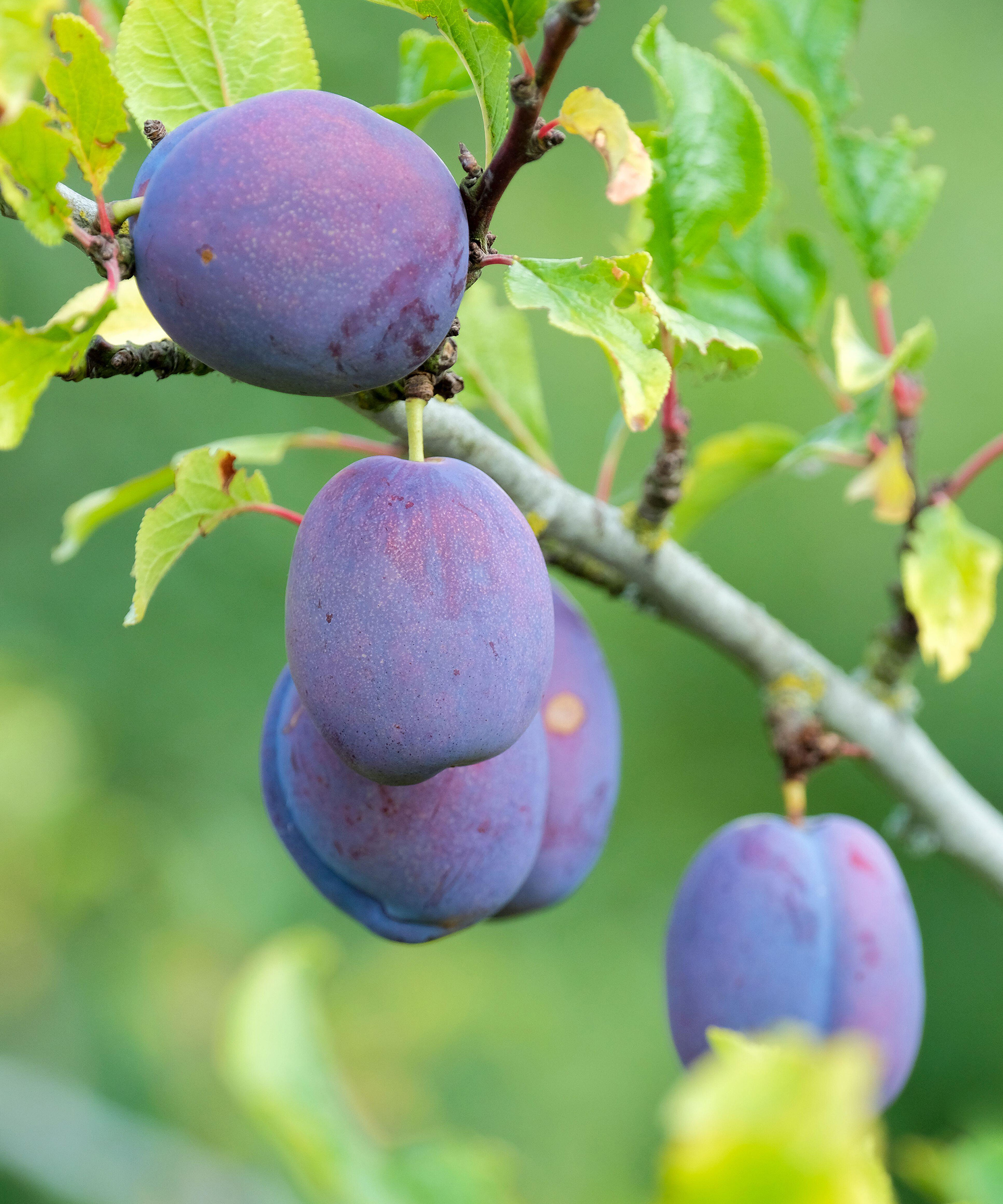
- Hardiness: USDA 5-9 (UK H6)
- Height: 7-9ft (2.1-2.7m) on VVA-1 rootstock; 10-12ft (3-3.6m) on Adaptabil rootstock
- Spread: 9-12ft (2.7-3.6m)
- Best for: Cottage gardens
A damson tree is a classic sight in traditional English cottage garden ideas, forming a dense small twiggy shape. Although damsons aren’t great for eating fresh, they are wonderful for cooking: for instance, the tart-skinned purple fruit is delicious in crumble, jam, and gin.
‘Shropshire Damson’ is one of the best self-fertile varieties for flavor, producing blue-purple fruits with a strong, rich, bitter, sugary taste. It is also a heritage crop from Shropshire, England dating back to the 17th century. Grow in sheltered full sun in well-drained soil.
Cherry trees
11. Prunus avium 'Summer Sun’

- Hardiness: USDA 5-8 (UK H6)
- Height: 8-10ft (2.4-3m) on Gisela 5 rootstock; 12-15ft (3-4.5m) on Colt rootstock
- Spread: 10-15ft (3-4.5m)
- Best for: Eating fresh
Sweet cherry trees produce clusters of jewel-like summer fruits for eating fresh from the tree. ‘Summer Sun’ is one of the best sweet cherries for cooler regions, making it ideal for the northern US states. It also boasts a good-looking upright spreading habit.
In spring, it produces white blossom that provides for bees; then, in summer, the delicious red to dark-red fruit is ready for picking. Being partially self-fertile, they will produce fruit on their own, but would benefit from a pollinating partner in the vicinity.
There's more tips on how to grow cherries in our guide.
12. Prunus cerasus ‘Morello’
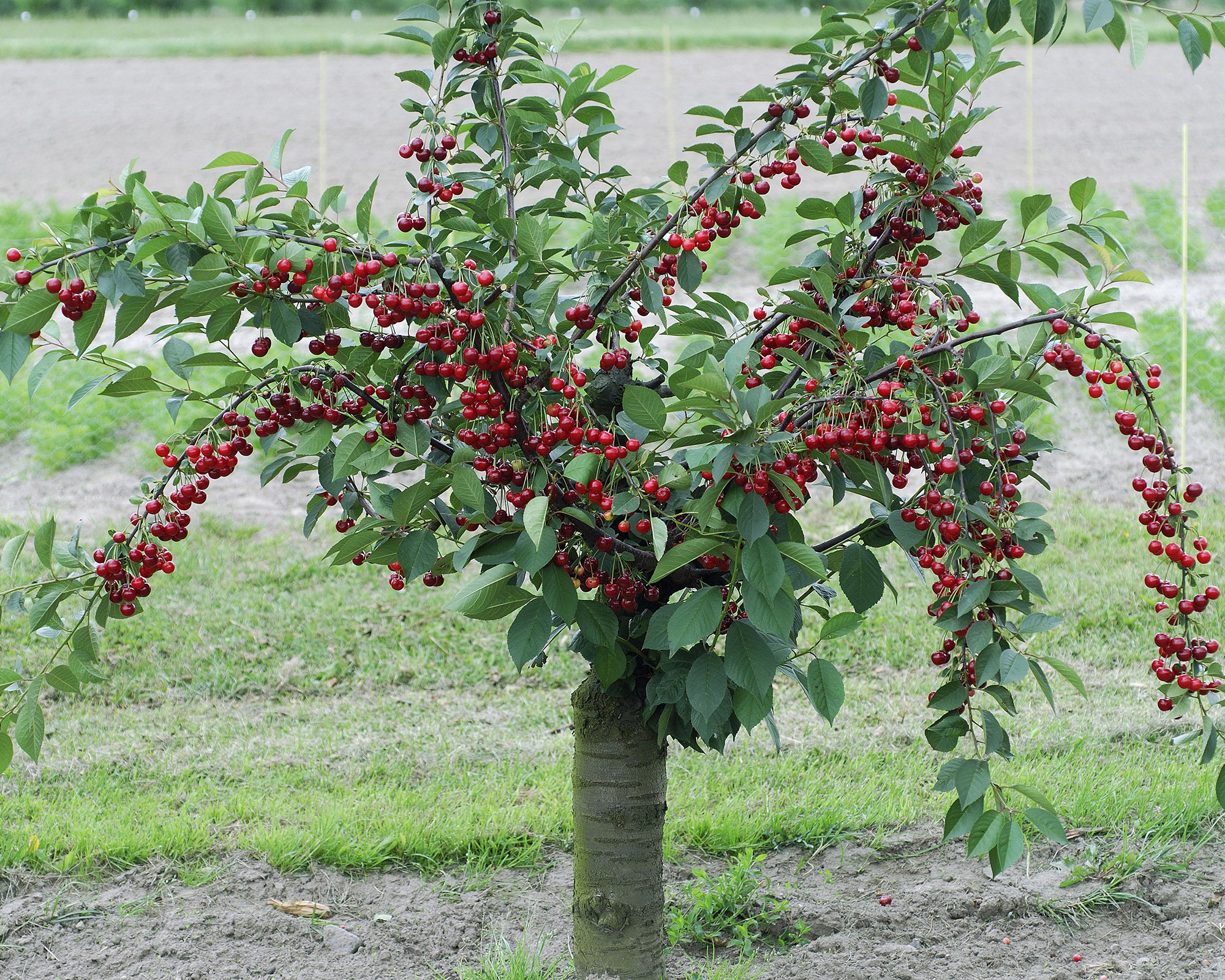
- Hardiness: USDA 4-8 (UK H6)
- Height: 8-10ft (2.4-3m) on Gisela 5 rootstock; 12-15ft (3-4.5m) on Colt rootstock
- Spread: 10-15ft (3-4.5m)
- Best for: Cherry pie
Cherries for cooking are known as sour or acid cherries – perfect for baking cherry pies and tarts and making jam. Unlike sweet cherries, they are tolerant of semi-shade, making them useful in north-facing gardens in the northern hemisphere.
’Morello’ is a fantastic self-fertile variety with beautiful snowy white blossom in spring and a reliable crop of dark-red summer fruit. It is also tolerant of colder weather, making it ideal for the UK and the northern US states. Grow in well-drained, retentive soil in sun or semi-shade.
Apricot trees
13. Prunus armeniaca 'Tomcot'
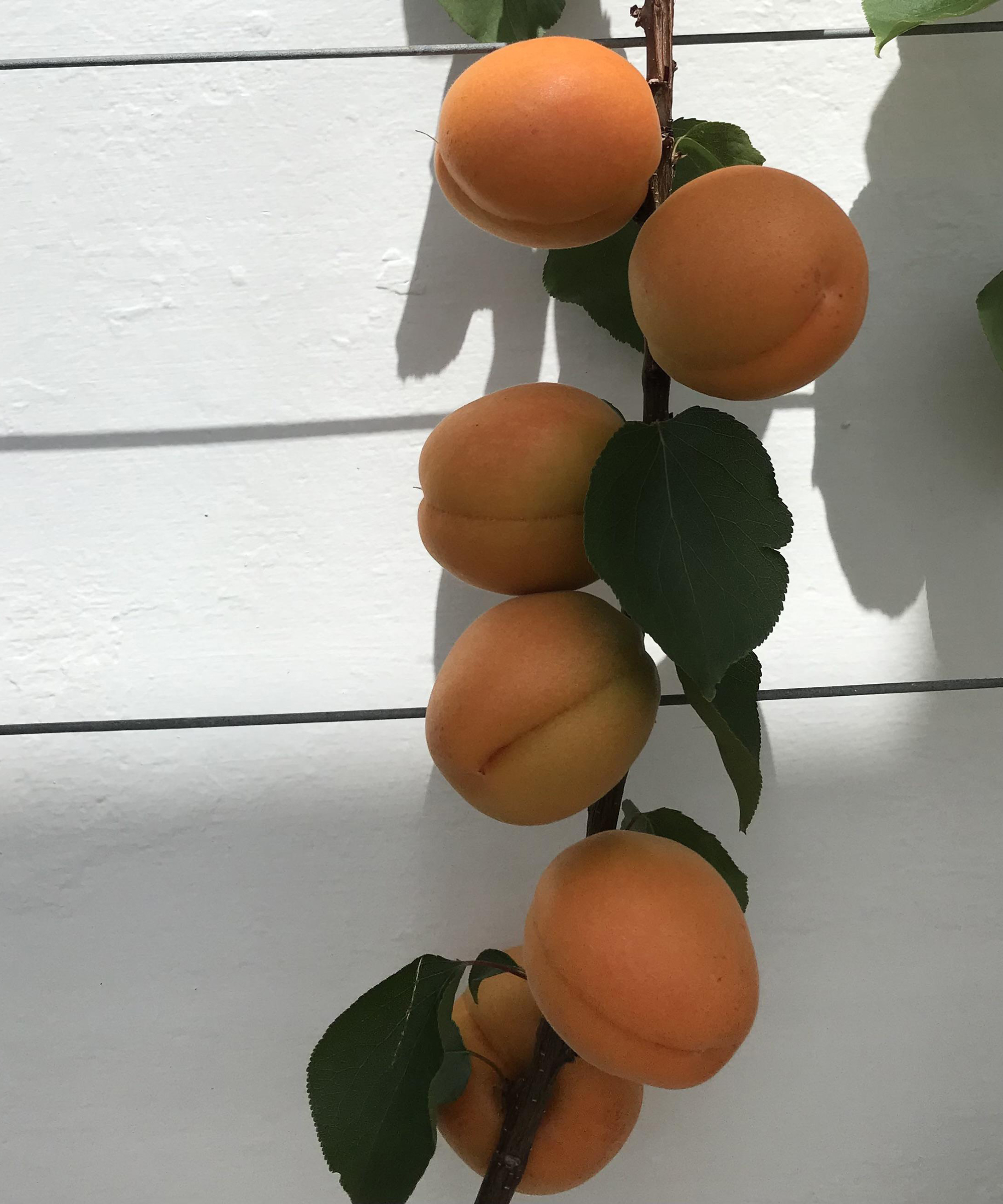
- Hardiness: USDA 6-9 (UK H4)
- Height: 9-11ft (2.7-3.3m)
- Spread: 11ft (3.3m)
- Best for: A garden wall
Many fruit trees (including apricots) can be grown against a wall in a fan shape, in order to save space, create an attractive feature that will add interest all year round, and protect plants from frost.
‘Tomcot’ is a modern, reliable, hardy American variety of apricot that provides blush spring blossom, and large tasty fruits that are orange washed with red. These can be eaten fresh or used to bake puddings and make jam.
If you don’t want to train the tree yourself, it can be bought ready-trained from a specialist fruit supplier and should be planted against a sheltered warm wall in deep, retentive, well-drained neutral to alkaline soil.
Peach and nectarine trees
14. Prunus persica 'Avalon Pride’

- Hardiness: USDA 6-9 (UK H4)
- Height: 7-9ft (2-3.3m) on VVA-1 rootstock; 10-12ft (3-3.6m) on Adaptabil rootstock
- Spread: 9-12ft (2.7-3.6m)
- Best for: Early spring color
The heavenly honeyed flavor of a juicy peach plucked from your own garden is hard to beat. However, peaches can be challenging to grow in the cool climates, where they are usually grown on a greenhouse wall and hand pollinated with a brush.
‘Avalon Pride’ is a fabulous disease-resistant self-fertile North American variety that produces stunning bright-pink flowers in early spring and delicious yellow-fleshed fruit in summer.
It also ripens earlier than many other peaches, making it possible to grow it outside on a sheltered warm wall. Buy it ready-trained as a fan and grow in well-drained, retentive soil in full sun.
15. Prunus persica var. nectarina 'Lord Napier'

- Hardiness: USDA 6-9 (UK H4)
- Height: 10-12ft (3-3.6m) on Adaptabil rootstock
- Spread: 12ft (3.6m)
- Best for: A greenhouse
If you dislike the furry jacket of a peach, smooth-skinned nectarines are for you. Just like peaches, they can be challenging to grow in damp, cool climates, but their juice fruit is so good, they are worth the effort.
‘Lord Napier’ is a self-fertile early cropper with golden and red-skinned large fruit that has fragrant, delicious white flesh. Protect the tree from rainfall during winter in order to prevent leaf curl or, alternatively, use a greenhouse to grow them. Since the plant flowers early, it’s also helpful to pollinate the blossom by hand using a brush.
16. Prunus persica var. nectarina ‘Nectarella’
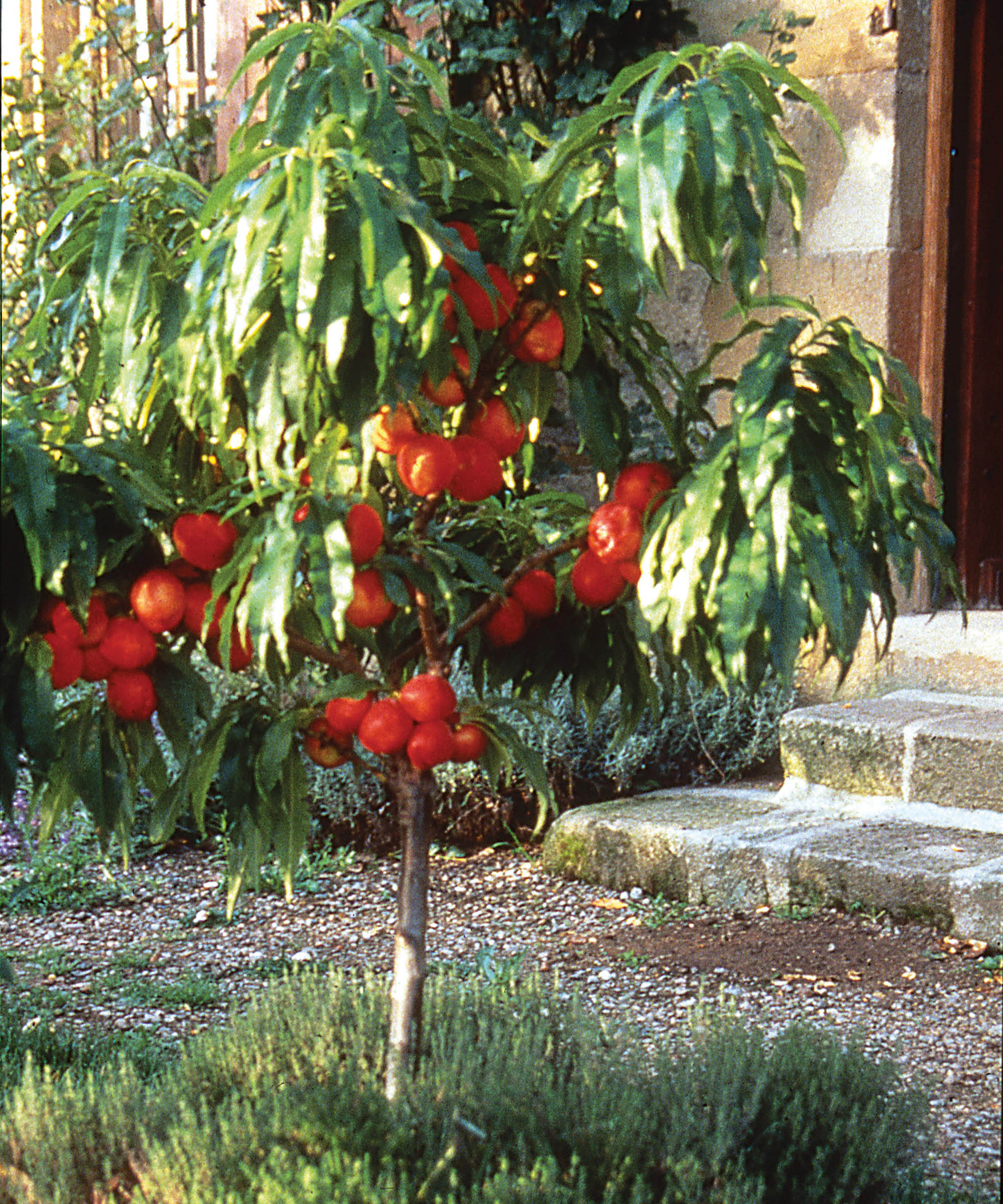
- Hardiness: USDA 6-9 (UK H4)
- Height: 5ft (1.5m)
- Spread: 5ft (1.5m)
- Best for: A patio or terrace
In a small garden or on a roof terrace, dwarf nectarines and peaches make excellent container gardening options, filling the air with wonderful perfume and providing a decent crop of succulent, delicious fruit.
‘Nectarella’ is a self-fertile Californian cultivar with pink spring blossom, tasty red and yellow fruit in summer, and attractive lance-shaped leaves. Being very slow-growing, it is an excellent dwarf nectarine for a pot.
Plant in a large (20in/50cm) well-drained container of loam-based compost and place in full sun. In cool climates, take the pot undercover during winter and spring or cover it, in order to shield the plant from leaf curl disease and frost.
Fig trees
17. Ficus carica 'Brown Turkey’
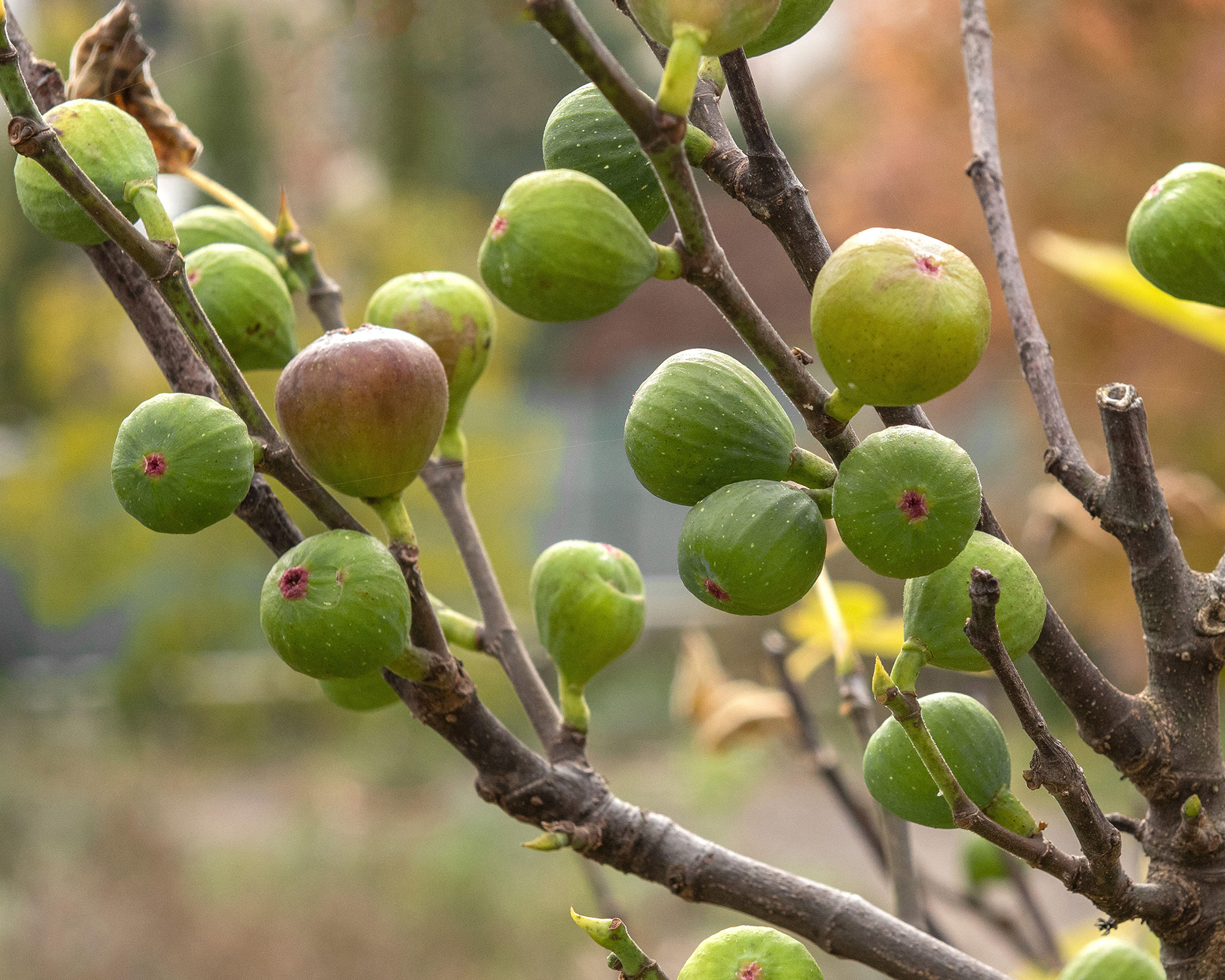
- Hardiness: USDA 6-10 (UK H4)
- Height: 10ft (3m)
- Spread: 13ft (4m)
- Best for: Foliage
For a blast of the Mediterranean, you can’t beat learning how to grow figs. Native to Greece and Central Asia, this fabulous plant loves sunshine, which encourages it to release a wonderful scent onto the air. When grown, its foliage will make it one of the best trees for privacy.
The large, lush leaves look good from spring to fall, and then the stems – if the plant is trained attractively against a wall – provide architectural structure throughout winter.
‘Brown Turkey’ is a hardy self-fertile variety for cooler regions, producing good fruit with sweet red flesh throughout late summer. Plant in well-drained neutral to alkaline soil in sheltered full sun.
Figs can be purchase ready-trained if you want to grow them against a wall, which is advisable in cold climates.
18. Ficus carica Little Miss Figgy
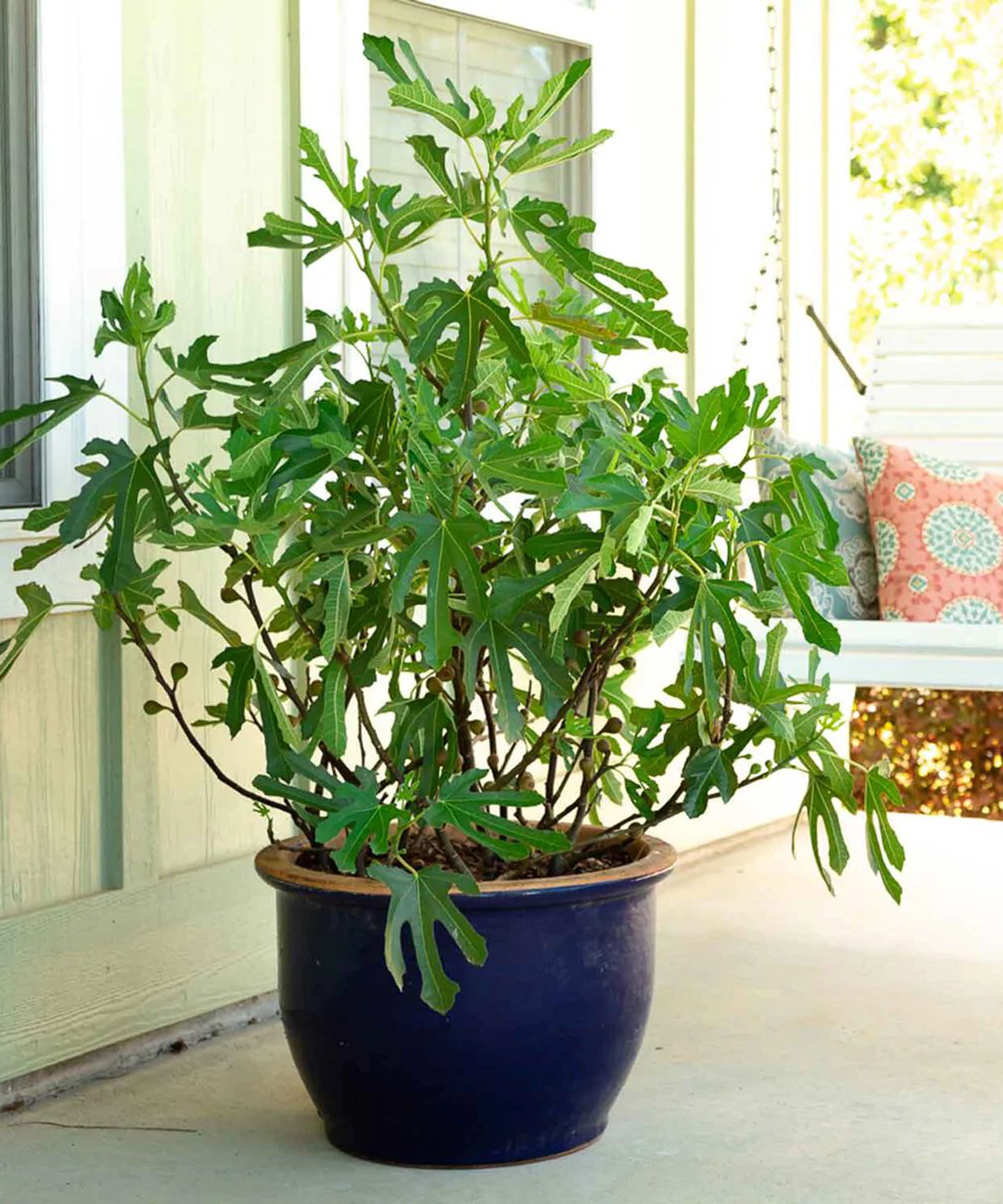
- Hardiness: USDA 6-10 (UK H4)
- Height: 4-6ft (1.2-1.8m)
- Spread: 3-4ft (90cm-1.2m)
- Best for: Double cropping
If you have a sun-drenched patio or terrace and want to create a Mediterranean mood, this exciting compact fig is a must-have for growing fruit in pots.
Discovered in South Carolina, Little Miss Figgy has the gorgeous lobed leaves of a full-size fig and delicious fruit, but remains small, making it ideal for enjoying in a container.
Ensure the pot has good drainage and place it in sheltered full sun. In cooler climates, it will fruit in late summer, but in warmer regions and glasshouses, will produce a second crop in spring.
Quince trees
19. Cydonia oblonga 'Vranja' Nenadovic

- Hardiness: USDA 5-8 (UK H5)
- Height: 10ft (3m)
- Spread: 10ft (3m)
- Best for: Scented fruit
Rarely seen in shops, with a unique, fragrant taste, and unsuitable for eating raw, quinces are a magical ingredient for gardeners who love to cook. Just one will fill a warm kitchen with its rosy honeyed-scent and, once added to the pot, will infuse this perfume into food.
Roast, bake, or poach them for delicious winter puddings or to add sweetness to savory dishes, or make tasty quince jelly to enjoy on toast or with cheese.
‘Vranja’ has pretty pink spring blossom and large pear-shaped fruit that ripen yellow in fall. Leaving the fruit on the tree encourages good flavor and quince can then be stored for 1-2 months indoors in a cool, dry place.
Think about the best plants for under trees to grow with your quince. Grow in well-drained, retentive soil in sheltered sun.
Citrus trees
20. Citrus x limon 'Garey's Eureka'
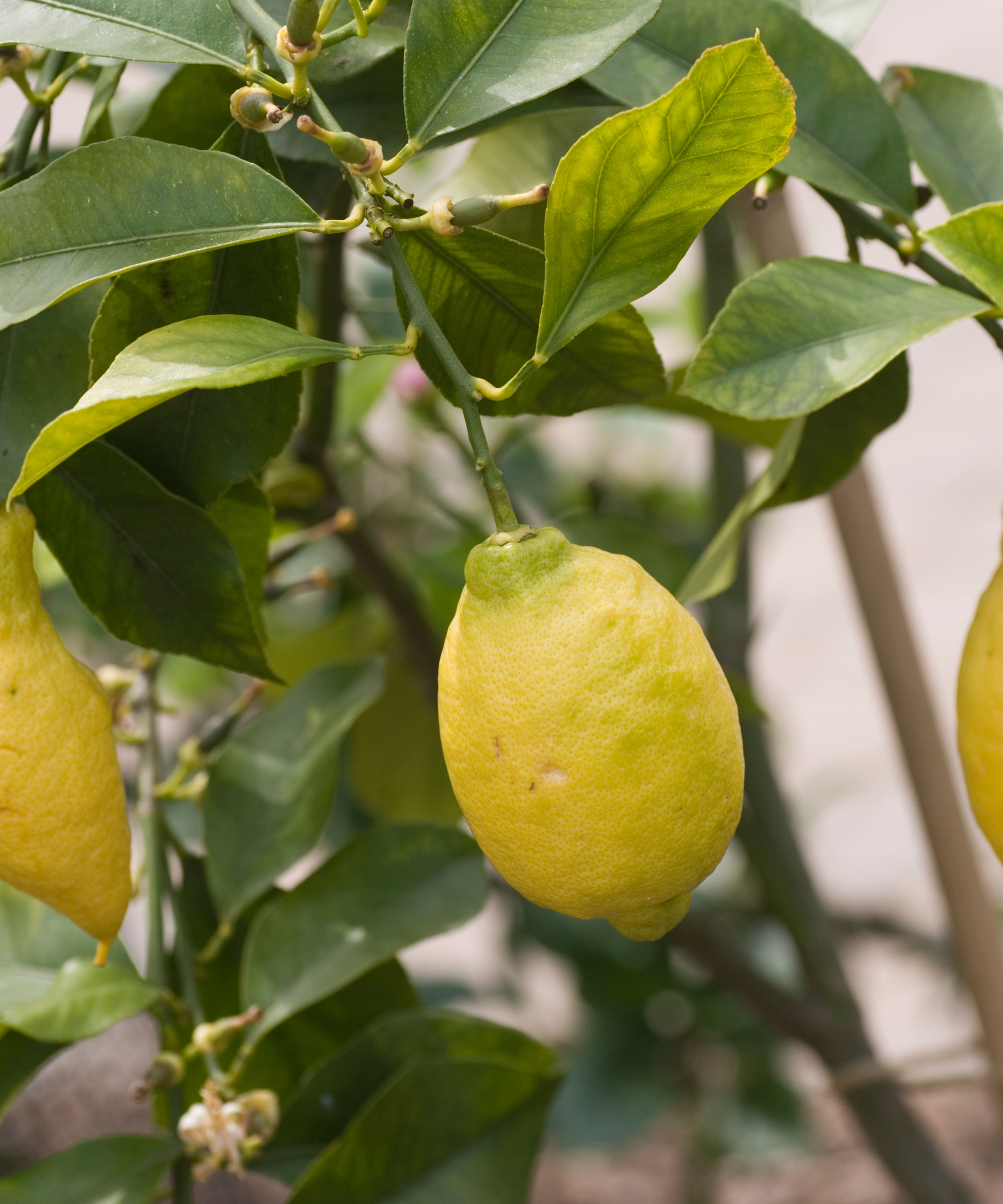
- Hardiness: USDA 9-11 (UK H2)
- Height: 3-5ft (90cm-1.5m)
- Spread: 3-5ft (90cm-1.5m)
- Best for: Mediterranean style
Flavor the evening’s gin and tonic with a slice of homegrown lemon by cultivating your own lemon trees. Grown in large terracotta planters they make wonderful additions to a Mediterranean garden, especially when you're sitting on the terrace during the warm summer months. They give the garden a romantic Tuscan feel and their flowers fill the air with scent.
'Garey's Eureka’ can produce flowers and good-flavored fruit over an impressively long period in the right conditions. In cool regions, citrus trees need the light, ventilation, and humidity of a glasshouse that never drops below 44˚F (7˚C); although 50˚F (10˚C) is a much better bottom line.
When the weather warms in early summer, wheel them out to enjoy the new season on the patio or terrace.
21. Citrus × latifolia ‘Tahiti’
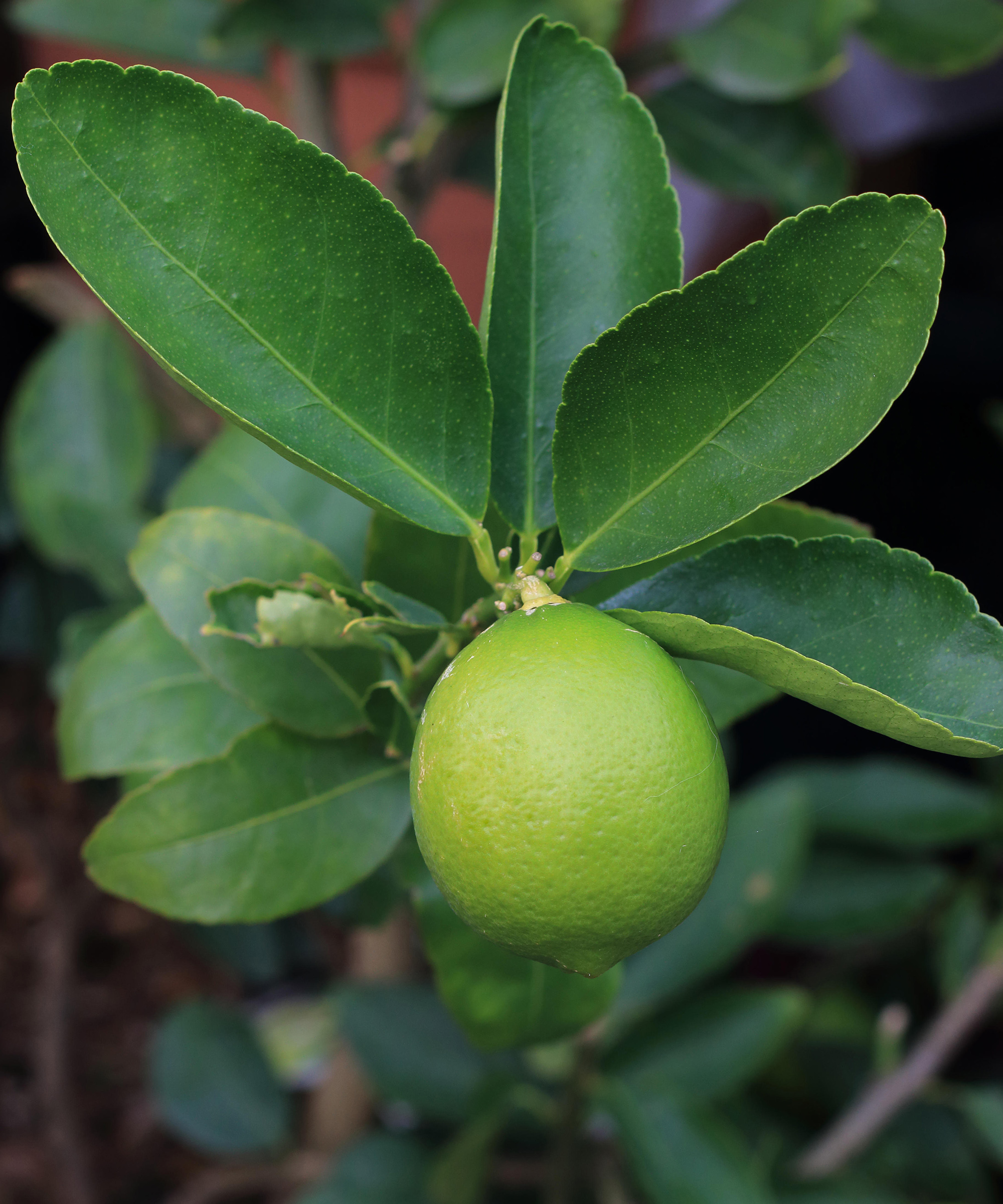
- Hardiness: USDA 9-11 (UK H2)
- Height: 3-5ft (90cm-1.5m)
- Spread: 3-5ft (90cm-1.5m)
- Best for: A conservatory
Wonderful in Mexican cuisine and perfect for flavoring cocktails, a lime is a useful addition to the right garden. ‘Tahiti’ is a great seedless variety, which – like all citrus – is self-fertile.
Citrus are some of the best fruit trees to grow in pots, and this variety is no exception. Plant in a well-drained ornamental container that is 20in (50cm) wide or more and invest in a plant caddy (a base with wheels), so you can move the pot indoors and outdoors easily; another option is to move large pots with a sack truck.
Fill the pot with citrus compost or make your own by mixing 80% John Innes No. 2 compost with 20% sharp sand or grit.
In cool regions, citrus require overwintering in a greenhouse that never plummets under 44˚F (7˚C); although 50˚F (10˚C) is a better limit.
22. Citrus × aurantium (Sweet Orange Group) 'Trovita'

- Hardiness: USDA 9-11 (UK H2)
- Height: 5ft (1.5m)
- Spread: 3ft (90cm)
- Best for: Scented flowers
Orange trees have deliciously scented white flowers that can bloom over a very long period and may be on the plant at the same time as the fruit. Orange blossom oil (known as neroli) is highly prized in perfumery and aromatherapy for its delicate, uplifting smell. So planting one of these in a pot on a terrace will ensure a beautifully fragrant summer garden.
In cooler regions, oranges require a well-ventilated warm glasshouse over winter and can be wheeled outside in summer to sit in sheltered full sun. ‘Trovita’ is an excellent heavy cropper that is ideal for juicing and eating.
Medlar trees
23. Mespilus germanica ‘Royal’

- Hardiness: USDA 5-8 (UK H6)
- Height: 8-10ft (2.4-3m) on Quince C rootstock; 10-12ft (3-3.6m) on Quince A rootstock
- Spread: 9-12ft (2.7-3.6m)
- Best for: Winter fruit
Once a popular, common fruit in England, medlars are now little-known, never mind little-grown. But they make some of the best fruit trees and their caramel-flavored fruit will delight adventurous cooks in the depths of winter.
‘Medlars are beautiful trees, unusual and easy to grow,’ says Karim Habibi, co-owner of Keepers Fruit Nursery in Kent, England. ‘The blossom comes late in the spring, and the tree matures to a good shape with attractive winter bark.’
‘Royal' is a compact, reliable self-fertile tree that has white blossom and produces tasty fruit late in the season. Harvest after the first hard frost and store in a dark, cool, dry place to induce ripening.
Mulberry trees
24. Morus nigra 'Chelsea'
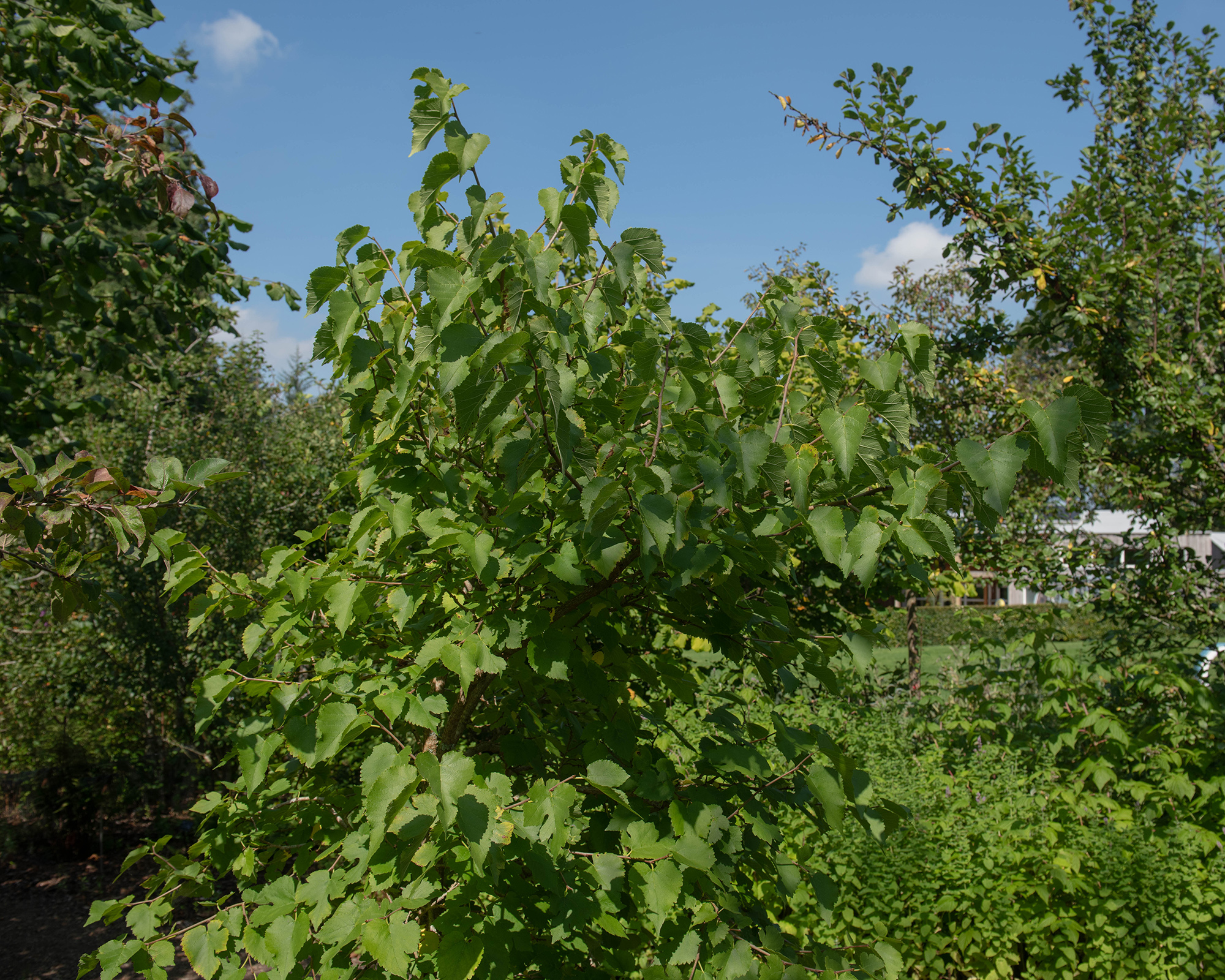
- Hardiness: USDA 5 to 9 (UK H6)
- Height: 30ft (9m)
- Spread: 30ft (9m)
- Best for: Patient gardeners
Taking to time grow and fruit, but wonderful in time, a mulberry is well worth planting in a large garden.
‘Chelsea' (syn. ‘King James’) is a spreading medium-sized medlar that develops enchanting gnarled bark over time. It is self-fertile and offers catkin-like green spring flowers and yellow leaves in fall, as well as large fruit that is produced on the tree from a relatively young age.
Grow in humus-rich well-drained soil in sheltered sun and allow the fruit to ripen (from red to black) fully before enjoying its sweet tangy flavor with ice cream or in desserts.
Which fruit tree grows the fastest?
‘Plum trees are the fastest growing fruit trees,’ says Karim Habibi. ‘But vigor really depends on the tree’s rootstock. Any plum (such as ‘Victoria’ or ‘Opal’) grown on Brompton rootstock will grow much larger than the same varieties grown on the dwarfing rootstock VVA-1.’
You'll find plenty more suggestions for fast-growing trees in our dedicated guide.
What is the easiest fruit tree to grow?
A standalone medlar or apple tree is fairly low-maintenance and unchallenging, making them both great plants for beginners or gardeners living busy lives.
Feed them in spring (with high potassium fertilizer) and prune them once a year to maintain an attractive shape and to boost flowering and fruit production.
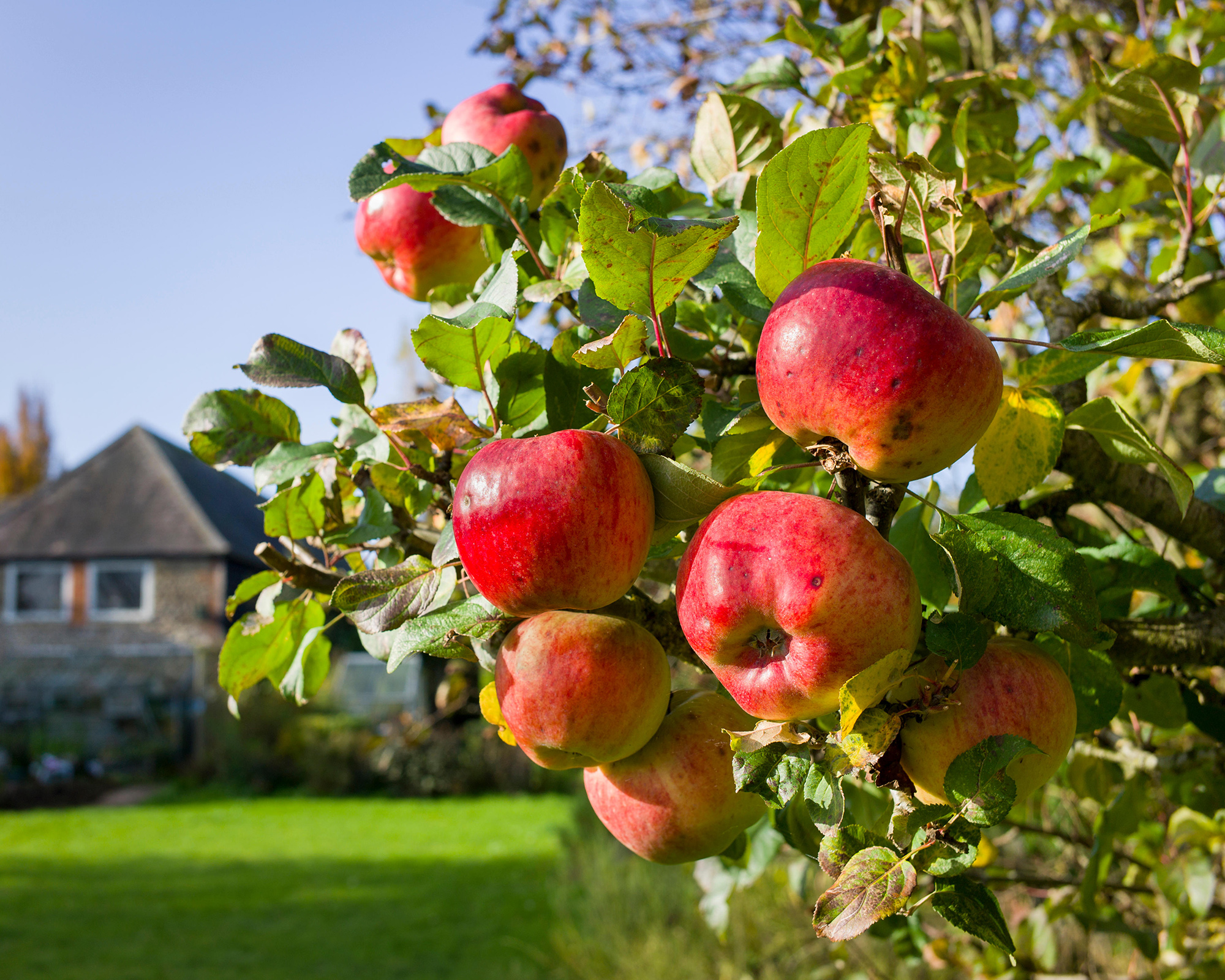
Which tree gives fruit all year round?
The lemon 'Gary's Eureka' can produce fruit for most of the year: with flowers from spring into early fall, and fruit from summer into winter. Being self-fertile, it can be grown alone, and reaching only 7ft (2.1m), it can be enjoyed in a container.
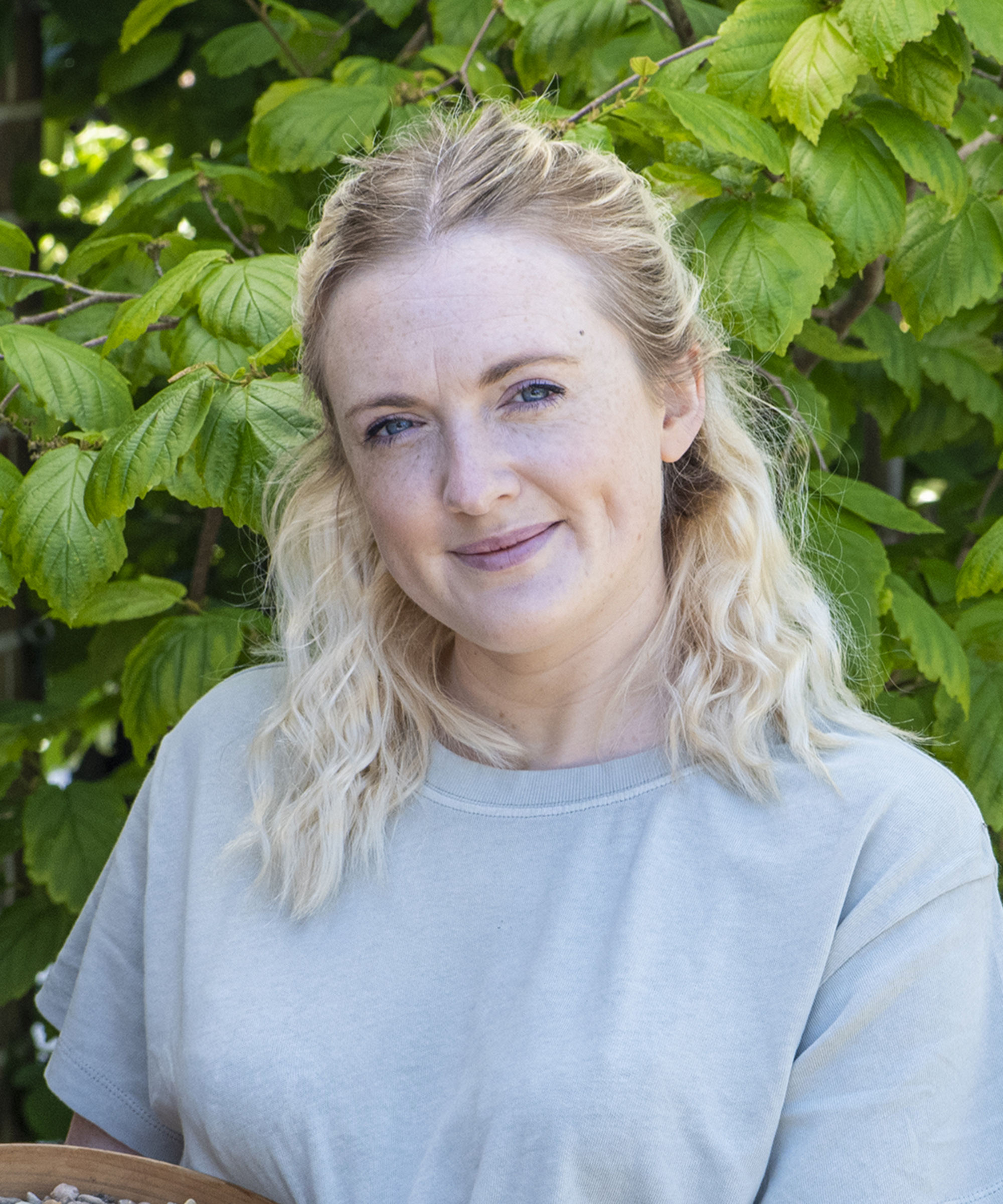
Teresa has worked as an Editor on a number of gardening magazines for three years now. So she is lucky enough to see and write about gardening across all sizes, budgets and abilities. She recently moved into her first home and the garden is a real project! Currently she is relishing planning her own design and planting schemes. What she is most passionate about when it comes to gardening are the positive effects it has on our mental health to grow and care for plants, as well as being great for the environment too and help provide food and shelter for wildlife.
